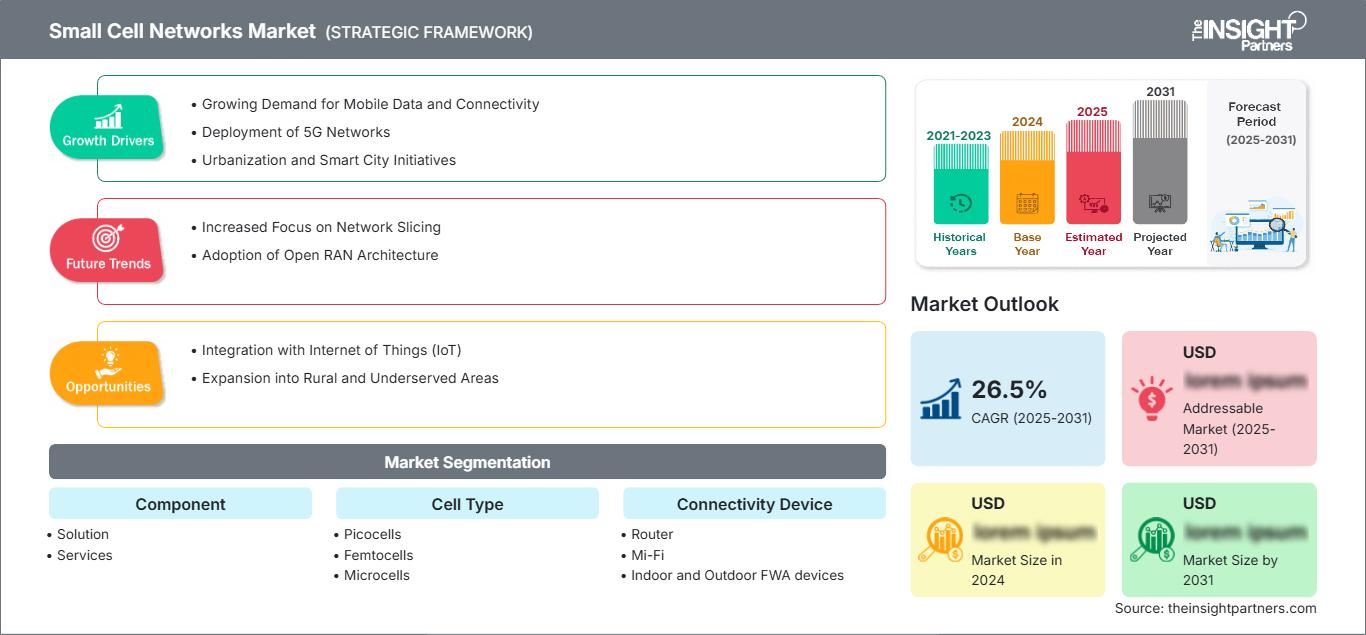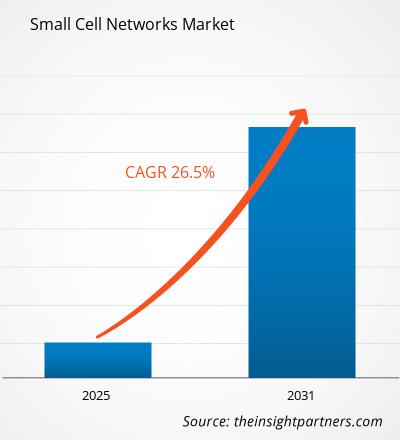The Small Cell Networks Market is expected to register a CAGR of 26.5% from 2025 to 2031, with a market size expanding from US$ XX million in 2024 to US$ XX Million by 2031.
The report is segmented by Component [Solution, Services (Consulting, Deployment and Integration, Training and Support and Maintenance)]; Cell Type (Picocells, Femtocells, Microcells, MetroCell); Connectivity Device (Router, Mi-Fi, Indoor and Outdoor FWA devices, Gateway, Others); Deployment (Outdoor, Indoor); End users (Residential, Commercial, Industrial). The global analysis is further broken-down at regional level and major countries. The report offers the value in USD for the above analysis and segments
Purpose of the Report
The report Small Cell Networks Market by The Insight Partners aims to describe the present landscape and future growth, top driving factors, challenges, and opportunities. This will provide insights to various business stakeholders, such as:
- Technology Providers/Manufacturers: To understand the evolving market dynamics and know the potential growth opportunities, enabling them to make informed strategic decisions.
- Investors: To conduct a comprehensive trend analysis regarding the market growth rate, market financial projections, and opportunities that exist across the value chain.
- Regulatory bodies: To regulate policies and police activities in the market with the aim of minimizing abuse, preserving investor trust and confidence, and upholding the integrity and stability of the market.
Small Cell Networks Market Segmentation
Component
- Solution
- Services
Cell Type
- Picocells
- Femtocells
- Microcells
- MetroCell
Connectivity Device
- Router
- Mi-Fi
- Indoor and Outdoor FWA devices
- Gateway
Deployment
- Outdoor
- Indoor
End users
- Residential
- Commercial
- Industrial
You will get customization on any report - free of charge - including parts of this report, or country-level analysis, Excel Data pack, as well as avail great offers and discounts for start-ups & universities
Small Cell Networks Market: Strategic Insights

- Get Top Key Market Trends of this report.This FREE sample will include data analysis, ranging from market trends to estimates and forecasts.
Small Cell Networks Market Growth Drivers
- Growing Demand for Mobile Data and Connectivity: The increasing reliance on mobile devices and the consequent surge in mobile data traffic are major drivers for the small cell networks market. As consumers and businesses demand faster and more reliable connectivity, traditional macrocell networks struggle to meet these needs, particularly in densely populated urban areas. Small cells, which enhance network capacity and coverage, are essential for delivering high-speed data services, making them an attractive solution for mobile operators aiming to improve user experience and satisfaction.
- Deployment of 5G Networks: The ongoing rollout of 5G technology is a significant driver for the small cell networks market. Small cells are integral to the 5G infrastructure, providing the necessary densification to support high-frequency bands and improved data rates. As telecommunications companies invest heavily in 5G deployment to meet consumer expectations for faster connectivity, the demand for small cell solutions will continue to grow. This trend is expected to accelerate the adoption of small cells as a key component of next-generation wireless networks.
- Urbanization and Smart City Initiatives: Urbanization is leading to increased population density in cities, which creates a pressing need for enhanced wireless connectivity. Small cell networks play a crucial role in smart city initiatives by providing the infrastructure necessary for Internet of Things (IoT) devices, smart traffic management, and enhanced public safety services. As cities strive to become smarter and more connected, the adoption of small cell networks is expected to rise, driving market growth and providing opportunities for innovation in urban telecommunications.
Small Cell Networks Market Future Trends
- Increased Focus on Network Slicing: A prominent trend in the small cell networks market is the increased focus on network slicing, particularly in the context of 5G technology. Network slicing allows operators to create multiple virtual networks on a single physical infrastructure, each tailored to specific use cases and service level agreements. This capability enhances the efficiency and flexibility of small cell deployments, enabling operators to better manage resources and deliver customized services to diverse user segments, such as enterprises, consumers, and IoT applications.
- Adoption of Open RAN Architecture: The shift towards Open RAN (Radio Access Network) architecture is a significant trend impacting the small cell networks market. Open RAN promotes interoperability and vendor diversity by allowing operators to mix and match components from different suppliers. This trend encourages innovation and reduces costs, enabling smaller players to enter the market. As telecommunications companies adopt Open RAN principles, the deployment of small cells will become more flexible and cost-effective, fostering a competitive landscape and accelerating market growth.
Small Cell Networks Market Opportunities
- Integration with Internet of Things (IoT): The proliferation of IoT devices presents significant opportunities for the small cell networks market. Small cells can support the connectivity needs of various IoT applications, such as smart meters, environmental monitoring, and smart transportation. As industries and municipalities increasingly adopt IoT solutions to optimize operations and enhance services, the demand for reliable and high-capacity small cell networks will grow. This creates a lucrative avenue for providers to develop tailored small cell solutions that cater to the specific needs of IoT applications.
- Expansion into Rural and Underserved Areas: There is a substantial opportunity for small cell networks to expand into rural and underserved areas where traditional macrocell networks may be insufficient. By deploying small cells in these regions, service providers can enhance coverage and improve connectivity for residents and businesses. This expansion not only addresses the digital divide but also opens new markets for telecommunications companies, as they can tap into previously underserved populations seeking reliable mobile connectivity.
Small Cell Networks Market Regional Insights
The regional trends and factors influencing the Small Cell Networks Market throughout the forecast period have been thoroughly explained by the analysts at The Insight Partners. This section also discusses Small Cell Networks Market segments and geography across North America, Europe, Asia Pacific, Middle East and Africa, and South and Central America.
Small Cell Networks Market Report Scope
| Report Attribute | Details |
|---|---|
| Market size in 2024 | US$ XX million |
| Market Size by 2031 | US$ XX Million |
| Global CAGR (2025 - 2031) | 26.5% |
| Historical Data | 2021-2023 |
| Forecast period | 2025-2031 |
| Segments Covered |
By Component
|
| Regions and Countries Covered | North America
|
| Market leaders and key company profiles |
|
Small Cell Networks Market Players Density: Understanding Its Impact on Business Dynamics
The Small Cell Networks Market is growing rapidly, driven by increasing end-user demand due to factors such as evolving consumer preferences, technological advancements, and greater awareness of the product's benefits. As demand rises, businesses are expanding their offerings, innovating to meet consumer needs, and capitalizing on emerging trends, which further fuels market growth.

- Get the Small Cell Networks Market top key players overview
Key Selling Points
- Comprehensive Coverage: The report comprehensively covers the analysis of products, services, types, and end users of the Small Cell Networks Market, providing a holistic landscape.
- Expert Analysis: The report is compiled based on the in-depth understanding of industry experts and analysts.
- Up-to-date Information: The report assures business relevance due to its coverage of recent information and data trends.
- Customization Options: This report can be customized to cater to specific client requirements and suit the business strategies aptly.
The research report on the Small Cell Networks Market can, therefore, help spearhead the trail of decoding and understanding the industry scenario and growth prospects. Although there can be a few valid concerns, the overall benefits of this report tend to outweigh the disadvantages.
Frequently Asked Questions
What are the options available for the customization of this report?
What are the deliverable formats of the small cell networks market report?
What are the future trends of small cell networks market?
What are the driving factors impacting global small cell networks market?
What is the expected CAGR of small cell networks market?
- Historical Analysis (2 Years), Base Year, Forecast (7 Years) with CAGR
- PEST and SWOT Analysis
- Market Size Value / Volume - Global, Regional, Country
- Industry and Competitive Landscape
- Excel Dataset
Recent Reports
Related Reports
Testimonials
Reason to Buy
- Informed Decision-Making
- Understanding Market Dynamics
- Competitive Analysis
- Identifying Emerging Markets
- Customer Insights
- Market Forecasts
- Risk Mitigation
- Boosting Operational Efficiency
- Strategic Planning
- Investment Justification
- Tracking Industry Innovations
- Aligning with Regulatory Trends





















 Get Free Sample For
Get Free Sample For